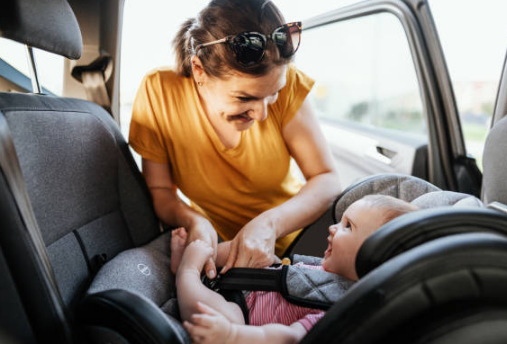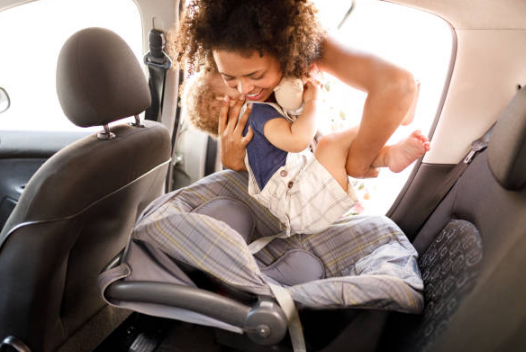Your baby may not be very happy when they are strapped to a car seat for the first time (or hundredth), but properly securing your newborn in a car seat is one of the most important things you can do to keep them safe. When you strap your baby to a car seat, you can reduce their risk of injury by 82%.
But simply strapping your baby to a seat belt won’t provide full protection in the event of an accident. Experts say that in order to keep your baby safe in the car, your baby’s height and weight must be within the limits of the car seat, the car seat must be properly installed in the car, and you must properly strap your baby to the seat belt. It may seem simple, but studies have shown that up to 59% of car seats are misused, which may reduce their effectiveness. Learn how to make sure you choose and use the right infant car seat with these expert tips.

Make Sure the Car Seat Fits
Car seats aren’t all the same. You’ll need to find a car seat that fits your baby’s age and size, and replace it when your child is too old to fit into the seat limitations. The National Highway Traffic Safety Administration has a helpful car seat finder that provides recommendations based on your child’s age, height, and weight.
According to the American Academy of Pediatrics (AAP), babies should sit in a car seat equipped with a five-point harness from birth until they reach the maximum weight limit recommended by the car seat manufacturer, which is 65 pounds to 90 pounds. Infants and toddlers should sit in a rear-facing car seat for as long as possible; Most convertible seats allow rear-facing seats to be used until the child weighs 40 pounds, but some seats are more restrictive.
Use the Correct Harness Slots
All infant and toddler car seats should be equipped with a five-point harness. This means that the belt buckle system is in contact with the five points on the child’s body – both shoulders, both hips and hips – to distribute the impact of a sudden stop or collision to their tiny body.
The backrest of the car seat has various slots that you can thread the five-point harness system through. If your child is facing rear, use the harness slots that are aligned with or slightly below your child’s shoulders. If your child is facing forward, use the slot that positions the harness on or slightly above your child’s shoulder. Since most car accidents happen while the car is moving forward, these different seat belt positions are most likely to protect your baby’s body in the event of a car accident.

Reclining Newborn Car Seats
Newborns don’t have enough neck strength to support their head in a rear-facing car seat. Their heads tend to tilt sideways; This is normal. However, when the car seat is too straight, their head tends to tilt forward, which is abnormal because it affects the baby’s breathing.
To support your baby’s head, tilt the rear-facing seat slightly so that the car seat is angled naturally so that your baby’s head is leaned back and their chin is away from their chest. As your child grows up and is able to lift their head, you can move the car seat to a more upright position.
Ensure a Comfortable Fit
Car seats won’t protect your baby unless you fasten their seatbelt. Once your baby’s five-point harness is fastened and fastened (make sure the clip is level with the armpit), you will need to perform a clamp test to make sure the harness is tight enough.
To do this, gently pinch the place where the carrier passes through your baby’s shoulder. If there is no slack and your fingers can slip off the carrier material, your baby is safe and comfortable. If you can easily pinch the carrier material away from your baby’s shoulder, you should tighten the carrier a bit.
Don’t try to use the “two-finger test” to check if your baby is wearing a seatbelt safely. Since everyone’s fingers are different in size, testing whether one or both fingers can be reached underneath the harness is considered an outdated way to ensure a comfortable fit for the harness.
Remove Heavy Clothing Before Buttoning It Up
Putting anything under a harness is dangerous except for babies, even if it’s a snowsuit or winter jacket. It may seem that a child wrapped in a blanket or jacket is tightly tied, but if they are wearing a coat made of fluffy material that may be compressed in the event of a collision, then there is a good chance that there is too much room for swinging between their bodies and seat belts. In the event of an accident, this space may be just enough for your baby to be pushed or even thrown out of the car seat.
The American Academy of Pediatrics recommends wearing close-fitting clothing for your baby when they sit in a car seat. If your baby needs extra warmth while driving, you can put a jacket or blanket over the buckled car seat.
